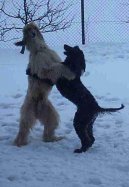Afghan hound (Dog standard)
Afghan hound gives the impression of strength and dignity, combining speed and power. head held proudly.
FCI-Standard N° 228 / 22 . 11. 2004 / GB
AFGHAN HOUND
ORIGIN : Afghanistan.
PATRONAGE : Great Britain.
DATE OF PUBLICATION OF THE ORIGINAL VALID STANDARD : 09.11.2004.
UTILIZATION : Sighthound.
CLASSIFICATION F.C.I. : Group 10 Sighthounds.
Section 1 Long-HAIRed or fringed
Sighthounds.
Without working trial.
GENERAL APPEARANCE : Gives the impression of strength and dignity, combining speed and power. HEAD held proudly.
BEHAVIOUR / TEMPERAMENT : Eastern or Oriental expression is typical of breed. The Afghan looks at and through one. Dignified and aloof, with a certain keen fierceness.
HEAD :
CRANIAL REGION :
Skull : Long, not too narrow with prominent occiput. Well balanced and mounted by a long « top-knot ».
Stop : Slight.
FACIAL REGION :
Nose : Preferably black, liver permissible in light-COLOURed dogs.
Muzzle : Long, with punishing jaws.
Jaws/Teeth : Jaws strong, with a perfect, regular and complete scissor bite, i.e. the upper teeth closely overlapping the lower teeth and set square to the jaws. Level bite tolerated.
Eyes : Dark for preference, but golden COLOUR not debarred. Nearly triangular, slanting slightly upwards from inner corner to outer.
Ears : Set low and well back, carried close to HEAD. Covered with long silky HAIR.
NECK : Long, strong with proud carriage of HEAD.
BODY :
Back : Level, moderate length, well muscled.
Loin : Straight, broad and rather short.
Croup : Falling slightly away to stern. Hipbones rather prominent and wide apart.
Chest : A fair spring of ribs and good depth.
TAIL : Not too short. Set on low with ring at end. Raised when in action. Sparsely feathered.
LIMBS
FOREQUARTERS : Forelegs straight and well boned, straight with shoulder viewed from front.
Shoulders : Long and sloping, set well back, well muscled and strong without being loaded.
Upper arm : Long and sloping.
Elbows : In profile vertically below the withers. Close to rib cage, turning neither in nor out.
Pasterns : Long and springy.
HINDQUARTERS : Powerful. Great length between hip and hock with comparatively short distance between hock and foot.
Stifles : Well bent and well turned.
Dewclaws : May be removed.
FEET : ForeFEET strong and very large both in length and breadth, and covered with long, thick HAIR; toes arched. Pads well down on ground. HindFEET long, but not quite as broad as foreFEET; covered with long thick HAIR.
GAIT / MOVEMENT : Smooth and springy with a style of high order.
COAT
HAIR : Long and very fine texture on ribs, fore and HINDQUARTERS and flanks. In mature dogs from shoulder backwards and along the saddle, HAIR short and close. HAIR long from foreHEAD backwards, with a distinct silky « top-knot ». On foreface HAIR short. Ears and legs well COATed. Pasterns can be bare. COAT must develop naturally.
COLOUR : All COLOURs acceptable.
SIZE : Ideal height : dogs 68-74 cm (27-29 ins); bitches 63-69 cm (25-27 ins).
FAULTS : Any departure from the foregoing points should be considered a fault and the seriousness with which the fault should be regarded should be in exact proportion to its degree and its effect upon the health and welfare of the dog.
Any dog clearly showing physical or behavioural abnormalities shall be disqualified.
N.B. : Male animals should have two apparently normal testicles fully descended into the scrotum.
Source: FCI >>> |




